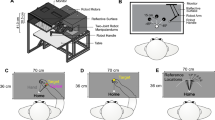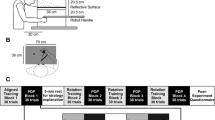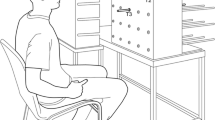Abstract
Individuals with Parkinson’s disease (PD) and healthy adults demonstrate similar levels of visuomotor adaptation provided that the distortion is small or introduced gradually, and hence, implicit processes are engaged. Recently, implicit processes underlying visuomotor adaptation in healthy individuals have been proposed to include proprioceptive recalibration (i.e., shifts in one’s proprioceptive sense of felt hand position to match the visual estimate of their hand experienced during reaches with altered visual feedback of the hand). In the current study, we asked if proprioceptive recalibration is preserved in PD patients. PD patients tested during their “off” and “on” medication states and age-matched healthy controls reached to visual targets, while visual feedback of their unseen hand was gradually rotated 30° clockwise or translated 4 cm rightwards of their actual hand trajectory. As expected, PD patients and controls produced significant reach aftereffects, indicating visuomotor adaptation after reaching with the gradually introduced visuomotor distortions. More importantly, following visuomotor adaptation, both patients and controls showed recalibration in hand position estimates, and the magnitude of this recalibration was comparable between PD patients and controls. No differences for any measures assessed were observed across medication status (i.e., PD off vs PD on). Results reveal that patients are able to adjust their sensorimotor mappings and recalibrate proprioception following adaptation to a gradually introduced visuomotor distortion, and that dopaminergic intervention does not affect this proprioceptive recalibration. These results suggest that proprioceptive recalibration does not involve striatal dopaminergic pathways and may contribute to the preserved visuomotor adaptation that arises implicitly in PD patients.




Similar content being viewed by others
References
Adamovich SV, Berkinblit MB, Hening W, Sage J, Poizner H (2001) The interaction of visual and proprioceptive inputs in pointing to actual and remembered targets in Parkinson’s disease. Neuroscience 104(4):1027–1041
Almeida QJ, Wishart LR, Lee TD (2002) Bimanual coordination deficits with Parkinson’s disease: the influence of movement speed and external cueing. Mov Disord 17(1):30–37
Almeida QJ, Frank JS, Roy EA, Jenkins ME, Spaulding S, Patla AE et al (2005) An evaluation of sensorimotor integration during locomotion toward a target in Parkinson’s disease. Neuroscience 134(1):283–293
Bedard P, Sanes JN (2011) Basal ganglia-dependent processes in recalling learned visual-motor adaptations. Exp Brain Res 209(3):385–393
Block HJ, Bastian AJ (2012) Cerebellar involvement in motor but not sensory adaptation. Neuropsychologia 50:1766–1775
Clayton HA, Cressman EK, Henriques DYP (2014) The effect of visuomotor adaptation on proprioceptive localization: the contributions of perceptual and motor changes. Exp Brain Res 232(7):2073–2086
Clower DM, Hoffman JM, Votaw JR, Faber TL, Woods RP, Alexander GE (1996) Role of posterior parietal cortex in the recalibration of visually guided reaching. Nature 383:618–621
Contreras-Vidal JL, Buch ER (2003) Effects of Parkinson’s disease on visuomotor adaptation. Exp Brain Res 150(1):25–32
Cressman EK, Henriques DY (2009) Sensory recalibration of hand position following visuomotor adaptation. J Neurophysiol 102(6):3505–3518
Cressman EK, Henriques DY (2010) Reach adaptation and proprioceptive recalibration following exposure to misaligned sensory input. J Neurophysiol 103(4):1888–1895
Cressman EK, Salomonczyk D, Henriques DY (2010) Visuomotor adaptation and proprioceptive recalibration in older adults. Exp Brain Res 205(4):533–544
Davidsdottir S, Wagenaar R, Young D, Cronin-Golomb A (2008) Impact of optic flow perception and egocentric coordinates on veering in Parkinson’s disease. Brain 131(Pt 11):2882–2893
Fahn S, Elton RL (1987) Unified Parkinson’s disease rating scale. In: Fahn S, Marsden CD, Goldstein M, Caine DB (eds) Recent developments in Parkinson’s disease, vol 2. Macmillan Healthcare Information, Florham Park, NJ, pp 153–163
Fuentes CT, Bastian AJ (2010) Where is your arm? Variations in proprioception across space and tasks. J Neurophysiol 103(1):164–171
Galea JM, Bestmann S, Beigi M, Jahanshahi M, Rothwell JC (2012) Action reprogramming in Parkinson’s disease: response to prediction error is modulated by levels of dopamine. Neuroscience 32(2):542–550
Henriques DY, Soechting JF (2003) Bias and sensitivity in the haptic perception of geometry. Exp Brain Res 150(1):95–108
Henriques DY, Filippopulos F, Straube A, Eggert T (2014) The cerebellum is not necessary for visually driven recalibration of hand proprioception. Neuropsychologia 64C:195–204
Hoehn MM, Yahr MD (1967) Parkinsonism: onset, progression and mortality. Neurology 17(5):427–442
Isaias IU, Moisello C, Marotta G, Schiavella M, Canesi M, Perfetti B, Ghilardi MF (2011) Dopaminergic striatal innervation predicts interlimb transfer of a visuomotor skill. J Neuroscience 31(41):14458–14462
Jacobs JV, Horak FB (2006) Abnormal proprioceptive-motor integration contributes to hypometric postural responses of subjects with Parkinson’s disease. Neuroscience 141(2):999–1009
Jones SA, Cressman EK, Henriques DY (2010) Proprioceptive localization of the left and right hands. Exp Brain Res 204(3):373–383
Kesten H (1958) Accelerated stochastic approximation. Ann Math Stat 29(1):41–59
Konczak J, Li KY, Tuite PJ, Poizner H (2008) Haptic perception of object curvature in Parkinson’s disease. PLoS ONE 3(7):e2625
Konczak J, Corcos DM, Horak F, Poizner H, Shapiro M, Tuite P, Volkmann J, Maschke M (2009) Proprioception and motor control in Parkinson’s disease. J Mot Behav 41(6):543–552
Lee AC, Harris JP, Atkinson EA, Fowler MS (2001) Disruption of estimation of body-scaled aperture width in Hemiparkinson’s disease. Neuropsychologia 39(10):1097–1104
Lee D, Henriques DY, Snider J, Song D, Poizner H (2013) Reaching to proprioceptively defined targets in Parkinson’s disease: effects of deep brain stimulation therapy. Neuroscience 244:99–112
Lewis SJ, Slabosz A, Robbins TW, Barker RA, Owen AM (2005) Dopaminergic basis for deficits in working memory but not attentional set-shifting in Parkinson’s disease. Neuropsychologia 43(6):823–832
Li KY, Pickett K, Nestrasil I, Tuite P, Konczak J (2010) The effect of dopamine replacement therapy on haptic sensitivity in Parkinson’s disease. Neurology 257(12):1992–1998
Mancini M, Rocchi L, Horak FB, Chiari L (2008) Effects of Parkinson’s disease and levodopa on functional limits of stability. Clin Biomech 23(4):450–458
Marinelli L, Crupi D, Di Rocco A, Bove M, Eidelberg D, Abbruzzese G, Ghilardi MF (2009) Learning and consolidation of visuo-motor adaptation in Parkinson’s disease. Parkinsonism Relat Disord 15(1):6–11
Maschke M, Tuite PJ, Krawczewski K, Pickett K, Konczak J (2006) Perception of heaviness in Parkinson’s disease. Mov Disord 21(7):1013–1018
McEntee WJ, Mair RG, Langlais PJ (1987) Neurochemical specificity of learning: dopamine and motor learning. Yale J Biol Med 60(2):187–193
McNeely ME, Duncan RP, Earhart GM (2012) Medication improves balance and complex gait performance in Parkinson disease. Gait Posture 36(1):144–148
Messier J, Adamovich S, Jack D, Hening W, Sage J, Poizner H (2007) Visuomotor learning in immersive 3D virtual reality in Parkinson’s disease and in aging. Exp Brain Res 179:457–474
Modchalingam S, Vachon CM, ‘t Hart BM, Henriques DYP (2019) The effects of awareness of the perturbation during motor adaptation on hand localization. PLoS ONE 14(8):e0220884
Mongeon D, Blanchet P, Messier J (2009) Impact of Parkinson’s disease and dopaminergic medication on proprioceptive processing. Neuroscience 158(2):426–440
Mongeon D, Blanchet P, Messier J (2013) Impact of Parkinson’s disease and dopaminergic medication on adaptation to explicit and implicit visuomotor perturbations. Brain Cogn 81(2):271–282
Mongeon D, Blanchet P, Bergeron S, Messier J (2015) Impact of Parkinson’s disease on proprioceptively based on-line movement control. Exp Brain Res 233(9):2707–2721
Morehead JR, Qasim SE, Crossley MJ, Ivry R (2015) Savings upon re-aiming in visuomotor adaptation. J Neurosci 35(42):14386–14396
Neville KM, Cressman EK (2018) The influence of awareness on explicit and implicit contributions to visuomotor adaptation over time. Exp Brain Res 236(7):2047–2059
O’Suilleabhain P, Bullard J, Dewey RB (2001) Proprioception in Parkinson’s disease is acutely depressed by dopaminergic medications. J Neurol Neurosurg Psychiatry 71(5):607–610
Owen AM, Iddon JL, Hodges JR, Summers BA, Robbins TW (1997) Spatial and non-spatial working memory at different stages of Parkinson’s disease. Neuropsychologia 35(4):519–532
Poizner H, Fookson OI, Berkinblit MB, Hening W, Feldman G, Adamovich S (1998) Pointing to remembered targets in 3-D space in Parkinson’s disease. Mot Control 2(3):251–277
Rickards C, Cody FW (1997) Proprioceptive control of wrist movements in Parkinson’s disease Reduced muscle vibration-induced errors. Brain 120(Pt 6):977–990
Ruttle JE, ‘t Hart BM, Henriques DY (2018) The fast contribution of visual-proprioceptive discrepancy to reach aftereffects and proprioceptive recalibration. PLoS ONE 13(7):e0200621
Salomonczyk D, Cressman EK, Henriques DY (2011) Proprioceptive recalibration following prolonged training and increasing distortions in visuomotor adaptation. Neuropsychologia 49(11):3053–3062
Salomonczyk D, Henriques DY, Cressman EK (2012) Proprioceptive recalibration in the right and left hands following abrupt visuomotor adaptation. Exp Brain Res 217(2):187–196
Salomonczyk D, Cressman EK, Henriques DY (2013) The role of the cross-sensory error signal in visuomotor adaptation. Exp Brain Res 228(3):313–325
Seidler RD, Bernard JA, Burutolu TB, Fling BW, Gordon MT, Gwin JT, Kwak Y, Lipps DB (2010) Motor control and aging: links to age-related brain structural, functional, and biochemical effects. Neurosci Biobehav Rev 34(5):721–733
Semrau JA, Perlmutter JS, Thoroughman KA (2014) Visuomotor adaptation in Parkinson’s disease: effects of perturbation type and medication state. J Neurophysiol 111(12):2675–2687
Shadmehr R, Krakauer JW (2008) A computational neuroanatomy for motor control. Exp Brain Res 185:359–381
Shadmehr R, Smith MA, Krakauer JW (2010) Error correction, sensory prediction, and adaptation in motor control. Ann Rev Neurosci 33:89–108
Simani MC, McGuire LM, Sabes PN (2007) Visual-shift adaptation is composed of separable sensory and task-dependent effects. J Neurophysiol 98(5):2827–2841
Swinnen SP, Van Langendonk L, Verschueren S, Peeters G, Dom R, De Weerdt W (1997) Interlimb coordination deficits in patients with Parkinson’s disease during the production of two-joint oscillations in the sagittal plane. Mov Disord 12(6):958–968
Takiyama K, Sakurada T, Shinya M, Sato T, Ogihara H, Komatsu T (2020) Larger, but not better, motor adaptation ability inherent in medicated parkinson’s disease patients revealed by a smart-device-based study. Scientific Reports 10(1):1–11
Treutwein B (1995) Adaptive psychophysical procedures. Vision Res 35:2503–2522
Vachon CM, Modchalingam S, ’t Hart BM, Henriques DYP (2020) The effect of age on visuomotor learning processes. PLoS ONE 15(9):e0239032
Vahdat S, Darainy M, Milner TE, Ostry DJ (2011) Functionally specific changes in resting-state sensorimotor networks after motor learning. J Neuroscienc 31:16907–16915
Van Beers RJ, Sittig AC, Van Der Gon JJD (1998) The precision of proprioceptive position sense. Exp Brain Res 122(4):367–377
Van Beers RJ, Wolpert DM, Haggard P (2002) When feeling is more important than seeing in sensorimotor adaptation. Curr Biol 12(10):834–837
Venkatakrishnan A, Banquet JP, Burnod Y, Contreras-Vidal JL (2011) Parkinson’s disease differentially affects adaptation to gradual as compared to sudden visuomotor distortions. Hum Mov Sci 30(4):760–769
Verschueren SM, Swinnen SP, Dom R, De Weerdt W (1997) Interlimb coordination in patients with Parkinson’s disease: motor learning deficits and the importance of augmented information feedback. Exp Brain Res 113(3):497–508
Wang J, Joshi M, Lei Y (2011) The extent of interlimb transfer following adaptation to a novel visuomotor condition does not depend on awareness of the condition. J Neurophysiol 106(1):259–264
Werner S, Van Aken BC, Hulst T, Frens MA, Van Der Geest JN, Strüder HK, Donchin O (2015) Awareness of sensorimotor adaptation to visual rotations of different size. PLoS ONE 10(4):1–18
Wiltshire K, Foster S, Kaye JA, Small BJ, Camicioli R (2005) Corpus callosum in neurodegenerative diseases: findings in Parkinson’s disease. Dement Geriatr Cogn Disord 20(6):345–351
Zbib B, Henriques DY, Cressman EK (2016) Proprioceptive recalibration arises slowly compared to reach adaptation. Exp Brain Res 234(8):2201–2213
Zia S, Cody F, O’Boyle D (2000) Joint position sense is impaired by Parkinson’s disease. Ann Neurol 47(2):218–228
Zia S, Cody FW, O’Boyle DJ (2002) Identification of unilateral elbow-joint position is impaired by Parkinson’s disease. Clin Anat 15(1):23–31
Acknowledgements
This work was supported by the J. P. Bickell Foundation, granted to DYPH.
Author information
Authors and Affiliations
Corresponding author
Additional information
Communicated by Winston D Byblow.
Publisher's Note
Springer Nature remains neutral with regard to jurisdictional claims in published maps and institutional affiliations.
Supplementary Information
Below is the link to the electronic supplementary material.
221_2021_6075_MOESM1_ESM.eps
Supplementary file1 S1. Visuomotor adaptation during reach training trials with an aligned and rotated cursor (Experiment 1). The mean angular deviation of the hand at peak velocity relative to the target is presented for each block (3 trials) of training when controls (diamonds), PD patients off meds (triangles), and PD patients on meds (circles) reached with an aligned (empty symbols) and rotated (filled symbols) cursor. Error bars reflect the standard error of the mean. (EPS 1608 KB)
221_2021_6075_MOESM2_ESM.eps
Supplementary file2 S2. Visuomotor adaptation during reach training trials with an aligned and translated cursor (Experiment 2). The mean lateral hand deviation at peak velocity relative to the target is presented for each block (3 trials) of training when controls (diamonds), PD patients off meds (triangles), and PD patients on meds (circles) reached with an aligned (empty symbols) and translated (filled symbols) cursor. Error bars reflect the standard error of the mean. (EPS 1239 KB)
Rights and permissions
About this article
Cite this article
Cressman, E.K., Salomonczyk, D., Constantin, A. et al. Proprioceptive recalibration following implicit visuomotor adaptation is preserved in Parkinson’s disease. Exp Brain Res 239, 1551–1565 (2021). https://doi.org/10.1007/s00221-021-06075-y
Received:
Accepted:
Published:
Issue Date:
DOI: https://doi.org/10.1007/s00221-021-06075-y




